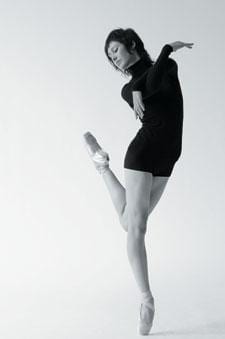“I just want torepresent in the world of classical ballet. People should know there’s a dyke who loves wearing a tutu.”
Meet the adorable Amber Munro, a corps de ballet member with the National Ballet of Canada.
“I always consider myself just one of the guys. I get that a lot at work. Even though they are men in tights, they’re still like, ‘Amber, you are one of the boys.’”
While gay boys are still considered the norm the 25-year-old Australian hopes her unique status as an out lesbian in ballet — we can’t think of another working at this level — might inspire those who’ve never considered seeing a ballet to look again.
“I love seeing the kids after a performance looking for autographs, but I want to see some women from the community out there.”
Munro grew up in Melbourne, Australia’s second largest city. Her father, a refrigeration mechanic, ran his own business; her mum was the bookkeeper. When she was five her mother enrolled her in dance classes — jazz, tap and ballet. “She noticed I was always prancing,” Munro says, “that every time music came on I would twirl here and there.”
At 11 she saw her first ballet, an Australian Ballet Company (ABC) production of Cinderella. Munro was hooked. Unlike most girls who fall under ballet’s spell, Munro wasn’t into the princess stuff. “I’m not someone who’s into pink and tiaras and glitter and jewels and everything,” she says. What attracted her was ballet’s unique theatricality. “The idea of expressing yourself through your body… the movement quality. I was drawn to the lines and the aesthetic beauty of what the body can do.”
Ballet became an obsession. “Discipline, always challenging yourself — that’s something I’m really into,” says Munro. She studied ballet fulltime, eventually winning a spot in the Australian Ballet School. At 19 she was chosen to participate in an exchange program with the National in Toronto, spending a month here. She liked the company, its repertoire and the city.
After graduating Munro danced with ABC for a full year, spent a few months with the Western Australia Company and then went on a three-month audition tour of Europe and North America. “The National was the first company I heard from that accepted me into their apprentice program. And I was like, ‘I’ll take it.’
“I always had this travel bug inside me, I always dreamed of living overseas, being independent, living by myself, getting a chance to know myself.
“Even when I was 18, I needed my own space, to be my own person and explore myself, my sexuality and anything else came along for the ride.
“I really felt like this was exactly what I needed.”
Like Munro, most of the 20 young women in the corps have come to the National from all over the world, leaving family far behind. So is it like America’s Next Top Model? “It’s not as intense,” Munro says, laughing. “Being in a very competitive field, obviously there’s going to be bitch-iness and cattiness…. Yes, there’s tension between people.
“But what it comes down to is working as a team. Sometimes that can be very frustrating, but when it works, it works really well. You really feel like we did this together.”
That camaraderie extends to the company’s easy acceptance of Munro, something she appreciates greatly. “I really have a lot of respect for the people.”
Because of an injury Munro sat out all of last year so she’s itching to get back on stage. “I’ve been feeling like an outsider. Coming back has been amazing.”
Munro is dancing in The Sleeping Beauty, Ruduolf Nureyev’s landmark production that put the National on the map when it toured in 1972. This opulent refurbished version is the floufiest thing ever. There are so many plumes whole sections of Munro’s native Australia must be populated with bald ostriches.
“Sleeping Beauty is the queen of classical ballet,” says Munro. “I find that underneath all the feathers and the glam and everything it’s very technically challenging…. It’s just really clean and clear and I really appreciate the beauty in that.”
Munro is also performing in two ballets in the mixed program, Balanchine’s 1946 masterpiece The Four Temperaments and Jerome Robbins’ Glass Pieces from 1983 (the year Balanchine died).
With its minimalist score by Philip Glass, the Robbins piece is a great showcase for the corps; at one point they slowly creep across the back of the stage as a sexy pas de deux takes centre stage. Munro loves it. “Words can’t express how I feel about it.”
Which is a good place to end a profile of a dancer.


 Why you can trust Xtra
Why you can trust Xtra


